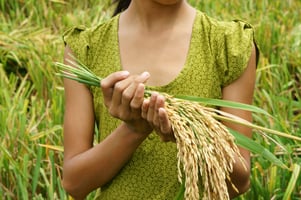Originally published : Fri, July 27, 2018 @ 3:39 PM
 Updated : Tue, December 11, 2018 @ 4:32 PM
Updated : Tue, December 11, 2018 @ 4:32 PM
Food security is a major global threat and traditional methods of plant and animal breeding will not be sufficient to increase production to the level needed to sustain the growing world population. Modern genomics-driven breeding, through analysis based on technologies such as next generation sequencing (NGS) and arrays, is revolutionizing agriculture and making genomic selection a viable approach throughout the industry. In this three series blog post find out how technology is changing global food security and what the newest tools bring to the table.
The power of genomic selection
Perhaps the biggest revolution in agriculture in the last decade is the emergence of agrigenomics to enhance traditional breeding programs. Molecular techniques, such as marker assisted selection and genomic selection, have enabled selection of improved varieties without having to rely on assessing visible characteristics. Genomic selection, in particular, addresses the key factors of the breeder’s equation (2) that increase the rate of genetic gain in plant and animal breeding:
- Reduced breeding cycles – individuals can be progressed faster when selection is based on genotype rather than phenotype alone
- Greater selection intensity – selecting individuals based on genotype is cheaper than selecting on phenotype, so more individuals can be evaluated (increasing ‘n’)
- Improved accuracy – the genomic estimated breeding value (GEBV) enables prediction models to select with greater accuracy based on phenotype and previous pedigree historical data and enables prediction models to be applied with greater accuracy.
- More efficient integration of new genetic material through the development of training population, where intensive phenotyping and genotyping can be assessed
Genomic selection has been instrumental in dairy cattle breeding where it has essentially replaced progeny testing, enabling greater and faster improvements in terms of genetic gain (see, for example, reference 3). Genomic selection has, however, had a relatively slow uptake in plant breeding. Reasons include its relative complexity compared to traditional methods, the need for expensive investments, complexity of plant genomes and ability to analyse big data using bioinformatics. The divergence of plant and animal breeding has also hindered the translation of methods between these two fields, but this problem is being addressed and hopefully both animal and plant breeding of the future will gain from common insights into genomic selection (1).
Technological development powers the agrigenomics breakthrough
Genomic selection has been made more practical by a range of methods, including next generation sequencing (NGS) and microarrays for genotyping and single nucleotide polymorphism (SNP) analysis. Massive developments in NGS technology in particular have realized the potential of genotyping by sequencing, (or GBS), and promises to revolutionize the drive to develop varieties of plant crops with, for example, desirable traits such as drought tolerance, disease resistance, and higher yield.
Despite all these advances, there are still gaps to fill in the toolbox of technologies, and finding the optimal solution for genomic selection can be a demanding process. We will be looking into these issues in the next article in this series.
Make sure you don't miss the rest of this series by subscribing to our blog!
About the author: Darshna 'Dusty' Vyas
Dusty has been with LGC for the last 6 years working as a plant genetics specialist.
Her career began at the James Hutton Institute, formerly the Scottish Crop Research Institute, developing molecular markers for disease resistance in raspberries. From there Dusty moved on to Biogemma UK Ltd for a period of 13 years, where she worked primarily with cereal crops such as wheat, maize and barley. Through her participation in the Artemisia Project, funded by the Bill and Melinda Gates Foundation, at York University, she gained a vast understanding of the requirements by breeders for varietal development using molecular markers in MAS.
Dusty's goal is to further breeding programs for global agricultural sustainability using high throughput methods such as SeqSNP.
References
- Genomic prediction unifies animal and plant breeding programs to form platforms for biological discovery. J M Hickey, T Chiurugwi, I Mackay, W Powell & Implementing Genomic Selection in CGIAR Breeding Programs Workshop Participants. Nature Genetics volume 49, pages 1297–1303 (2017)
- Animal breeding plans 2nd J L Lush. The Iowa State College Press (1943)
- Genomic selection strategies in a small dairy cattle population evaluated for genetic gain and profit. J R Thomasen et al, J. Dairy Sci. 97:458–470. http://dx.doi.org/10.3168/jds.2013-6599 (2014).

